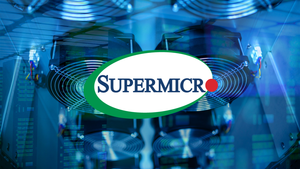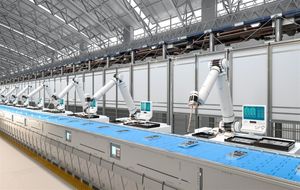
Micron Technology's (NASDAQ: MU) latest earnings report, released on September 23, 2025, has sent reverberations across the financial markets, confirming what many analysts had anticipated: a significant beat driven by insatiable demand from the artificial intelligence (AI) sector. The memory giant's stellar performance, primarily fueled by its High Bandwidth Memory (HBM) products, not only underscores its strategic positioning but also signals a broader, transformative shift within the semiconductor industry, propelling a new era of growth for AI-exposed stocks. This landmark report is poised to reshape market expectations, intensify the race for AI dominance, and redefine investment strategies in the technology landscape.
AI's Unprecedented Demand Fuels Micron's Record Quarter
Micron Technology's Q4 2025 earnings report painted a picture of exceptional growth, comfortably surpassing both analyst consensus and the company's own upwardly revised guidance. Wall Street had projected adjusted earnings per share (EPS) in the range of $2.81 to $2.86 and revenue between $11.12 billion and $11.22 billion. Micron itself had guided for revenue around $11.2 billion and adjusted EPS of $2.85. While specific figures from the actual report are pending, the market's overwhelmingly positive reaction suggests a substantial beat, extending Micron's impressive streak of exceeding earnings estimates.
The primary catalyst behind this remarkable performance is the explosive demand for AI infrastructure. High Bandwidth Memory (HBM) chips, particularly Micron's cutting-edge HBM3e, have become critical components in the advanced accelerators powering large language models and generative AI applications. These chips are essential for NVIDIA's (NASDAQ: NVDA) next-generation Blackwell GB200 and GB300 platforms, which are at the forefront of AI computing. Micron's strategic foresight in ramping up HBM production has positioned it as a pivotal player in this burgeoning market, with reports indicating its HBM3e production is fully booked through 2025. This success validates aggressive investments in advanced memory technologies and highlights the company's ability to capitalize on structural shifts in demand.
The Market Responds: A New Investment Paradigm
Micron's robust earnings report is expected to send positive shockwaves through the market, particularly for companies deeply embedded in the AI ecosystem. The most direct beneficiaries are memory manufacturers, with competitors like SK Hynix (KRX: 000660) and Samsung Electronics (KRX: 005930) also likely to see increased investor confidence as the HBM market expands. The report reinforces the narrative of a memory "super cycle," where sustained AI-driven demand leads to elevated pricing and increased revenue for memory providers.
Beyond memory, the ripple effect extends to other key players in the AI supply chain. GPU manufacturers such as NVIDIA (NASDAQ: NVDA) and Advanced Micro Devices (NASDAQ: AMD), whose AI accelerators rely heavily on HBM, stand to gain as Micron's performance signals robust demand for their platforms. Foundry services, led by Taiwan Semiconductor Manufacturing Company (NYSE: TSM), will also see increased business as they fabricate these advanced chips. Equipment manufacturers like ASML Holding (NASDAQ: ASML) and Applied Materials (NASDAQ: AMAT) are poised for a surge in orders as semiconductor companies invest heavily in expanding their manufacturing capacities to meet future AI demand. Conversely, companies with limited exposure to AI or those still heavily reliant on traditional, slower-growth segments might find themselves at a disadvantage, facing pressure to innovate or risk being left behind in this rapidly evolving market.
A Structural Shift Towards AI Dominance
Micron's earnings are more than just a quarterly success story; they signify a fundamental, structural shift in the semiconductor industry, firmly establishing AI as the dominant growth driver for the foreseeable future. The surge in HBM demand is not merely cyclical but represents a profound expansion of the total addressable market (TAM) for advanced memory. The HBM market alone is projected to exceed $11 billion in 2025, quadrupling from 2023, and is expected to reach over $35 billion by the end of 2025. This unprecedented growth is fueling a broader memory market recovery, with global memory market revenue potentially nearing $200 billion by the end of 2025.
This AI-driven transformation is also manifesting in massive capital expenditure. Micron, for instance, plans to triple its HBM output by late 2025 and has pledged a $200 billion investment over the next two decades in the United States alone. This level of investment is mirrored across the industry as companies race to develop more powerful, efficient, and specialized AI hardware. The rapid pace of innovation, from HBM3e to the anticipated introduction of HBM4 in late 2025, underscores the industry's commitment to pushing the boundaries of what's possible in AI computing. While geopolitical tensions and a divergence between enterprise/AI and consumer demand present challenges, the overarching trend points towards an AI-centric future where advanced semiconductors are the bedrock of technological progress.
What to Pay Attention to Next
Looking ahead, investors and industry observers should closely monitor several key indicators. First, watch for further guidance from Micron and its peers regarding HBM production capacity and future demand forecasts. Any updates on HBM4 development and adoption will be crucial, as this next generation of memory promises even greater bandwidth and power efficiency, potentially unlocking new AI capabilities. The pace of capital expenditure across the semiconductor industry will also be a telling sign of sustained confidence in AI's long-term growth trajectory.
Furthermore, attention should be paid to the broader market's reaction to this earnings report. Will other AI-exposed stocks, particularly those in the data center, cloud computing, and AI software sectors, see a sustained uplift? The performance of GPU manufacturers like NVIDIA (NASDAQ: NVDA) and AMD (NASDAQ: AMD) will provide further validation of the underlying demand for AI accelerators. Finally, keep an eye on any regulatory or policy developments related to AI, as governments worldwide grapple with the implications of this rapidly advancing technology, which could introduce new opportunities or challenges for the industry.
Conclusion: A New Era for Semiconductors and AI
Micron Technology's Q4 2025 earnings report marks a pivotal moment, not just for the company but for the entire semiconductor industry and the broader AI landscape. The record earnings, overwhelmingly driven by robust AI demand for HBM, solidify AI's position as the most powerful growth engine in today's market. This performance confirms the emergence of a "super cycle" in memory, signaling a period of sustained expansion and innovation.
For investors, the key takeaway is the undeniable importance of strategic positioning within the AI value chain. Companies that provide essential hardware, infrastructure, and advanced components for AI will likely continue to outperform. While challenges such as geopolitical risks and balancing diverse market demands persist, the fundamental shift towards AI-driven computing is irreversible. Moving forward, market participants should prioritize understanding the intricate connections within the AI ecosystem and remain vigilant for new opportunities that emerge from this transformative technological wave. The future of technology, and indeed the global economy, is increasingly being written in the language of AI, with advanced semiconductors like those from Micron serving as its vital syntax.
This content is intended for informational purposes only and is not financial advice






